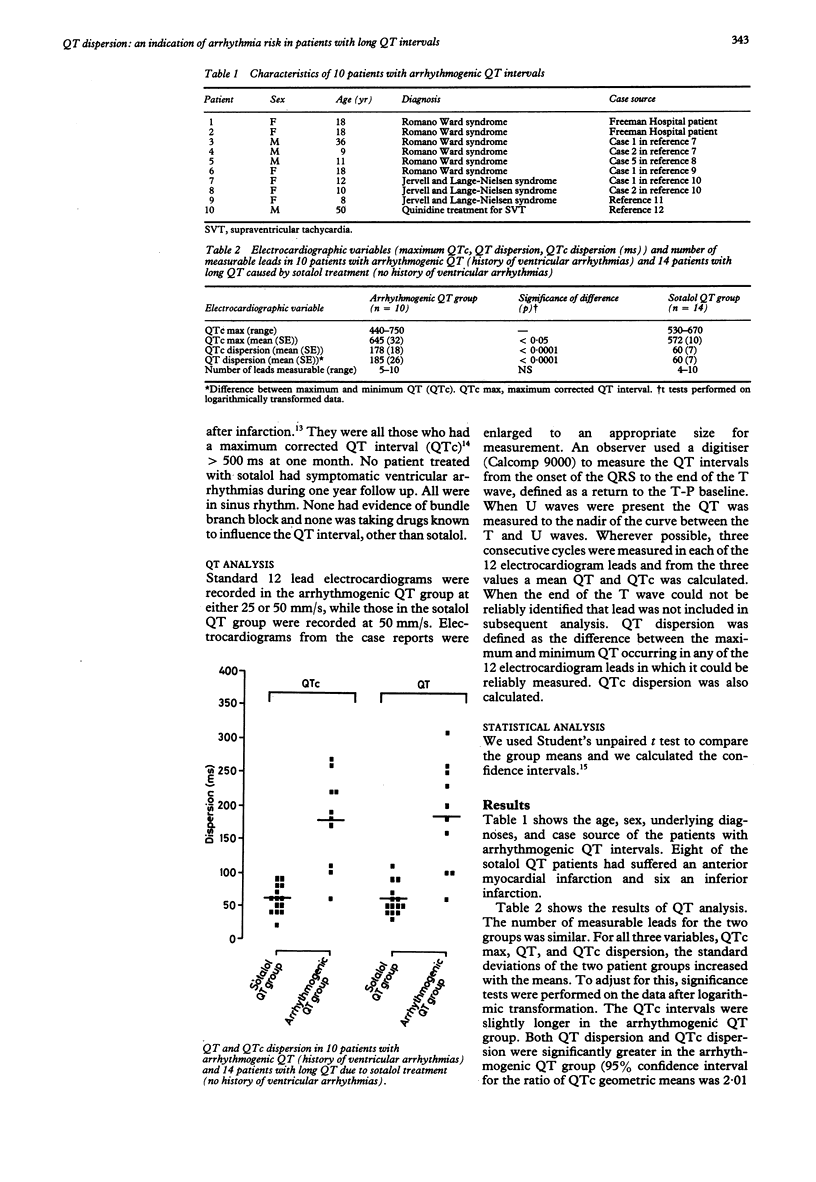Abstract
Homogeneity of recovery time protects against arrhythmias whereas dispersion of recovery time is arrhythmogenic. A single surface electrocardiographic QT interval gives no information on recovery time dispersion but the difference between the maximum and minimum body surface QT interval may be relevant. This hypothesis was tested by measuring the dispersion of the corrected QT interval (QTc) in 10 patients with an arrhythmogenic long QT interval (Romano Ward and Jervell and Lange-Nielsen syndromes or drug arrhythmogenicity) and in 14 patients without arrhythmias in whom the QT interval was prolonged by sotalol. QTc dispersion was significantly greater in the arrhythmogenic QT group than in the sotalol QT group. In patients with prolonged QT intervals, QT dispersion distinguished between those with ventricular arrhythmias and those without. This supports the hypothesis that QT dispersion reflects spatial differences in myocardial recovery time. QT dispersion may be useful in the assessment of both arrhythmia risk and the efficacy of antiarrhythmic drugs.
Full text
PDF


Selected References
These references are in PubMed. This may not be the complete list of references from this article.
- Arcebal A. G., Lemberg L. Torsade de pointes. Heart Lung. 1980 Nov-Dec;9(6):1096–1100. [PubMed] [Google Scholar]
- Cowan J. C., Hilton C. J., Griffiths C. J., Tansuphaswadikul S., Bourke J. P., Murray A., Campbell R. W. Sequence of epicardial repolarisation and configuration of the T wave. Br Heart J. 1988 Nov;60(5):424–433. doi: 10.1136/hrt.60.5.424. [DOI] [PMC free article] [PubMed] [Google Scholar]
- Cowan J. C., Yusoff K., Moore M., Amos P. A., Gold A. E., Bourke J. P., Tansuphaswadikul S., Campbell R. W. Importance of lead selection in QT interval measurement. Am J Cardiol. 1988 Jan 1;61(1):83–87. doi: 10.1016/0002-9149(88)91309-4. [DOI] [PubMed] [Google Scholar]
- Gardner M. J., Altman D. G. Confidence intervals rather than P values: estimation rather than hypothesis testing. Br Med J (Clin Res Ed) 1986 Mar 15;292(6522):746–750. doi: 10.1136/bmj.292.6522.746. [DOI] [PMC free article] [PubMed] [Google Scholar]
- Gavrilescu S., Luca C. Right ventricular monophasic action potentials in patients with long QT syndrome. Br Heart J. 1978 Sep;40(9):1014–1018. doi: 10.1136/hrt.40.9.1014. [DOI] [PMC free article] [PubMed] [Google Scholar]
- HAN J., MOE G. K. NONUNIFORM RECOVERY OF EXCITABILITY IN VENTRICULAR MUSCLE. Circ Res. 1964 Jan;14:44–60. doi: 10.1161/01.res.14.1.44. [DOI] [PubMed] [Google Scholar]
- Inoue H., Toda I., Nozaki A., Matsuo H., Sugimoto T. Effects of bretylium tosylate on inhomogeneity of refractoriness and ventricular fibrillation threshold in canine hearts with quinidine-induced long QT interval. Cardiovasc Res. 1985 Oct;19(10):655–660. doi: 10.1093/cvr/19.10.655. [DOI] [PubMed] [Google Scholar]
- James T. N., Froggatt P., Atkinson W. J., Jr, Lurie P. R., McNamara D. G., Miller W. W., Schloss G. T., Carroll J. F., North R. L. De subitaneis mortibus. XXX. Observations on the pathophysiology of the long QT syndromes with special reference to the neuropathology of the heart. Circulation. 1978 Jun;57(6):1221–1231. doi: 10.1161/01.cir.57.6.1221. [DOI] [PubMed] [Google Scholar]
- Jervell A., Thingstad R., Endsjö T. O. The surdo-cardiac syndrome: three new cases of congenital deafness with syncopal attacks and Q-T prolongation in the electrocardiogram. Am Heart J. 1966 Nov;72(5):582–593. doi: 10.1016/0002-8703(66)90340-1. [DOI] [PubMed] [Google Scholar]
- Johansson B. W., Jorming B. Hereditary prolongation of QT interval. Br Heart J. 1972 Jul;34(7):744–751. doi: 10.1136/hrt.34.7.744. [DOI] [PMC free article] [PubMed] [Google Scholar]
- Kuo C. S., Munakata K., Reddy C. P., Surawicz B. Characteristics and possible mechanism of ventricular arrhythmia dependent on the dispersion of action potential durations. Circulation. 1983 Jun;67(6):1356–1367. doi: 10.1161/01.cir.67.6.1356. [DOI] [PubMed] [Google Scholar]
- Mathews E. C., Jr, Blount AW BLOUNT A. W., Jr, Townsend J. I. Q-T prolongation and ventricular arrhythmias, with and without deafness, in the same family. Am J Cardiol. 1972 May;29(5):702–711. doi: 10.1016/0002-9149(72)90174-9. [DOI] [PubMed] [Google Scholar]
- Reingold A. L., Dan B. B., Shands K. N., Broome C. V. Toxic-shock syndrome not associated with menstruation. A review of 54 cases. Lancet. 1982 Jan 2;1(8262):1–4. doi: 10.1016/s0140-6736(82)92552-1. [DOI] [PubMed] [Google Scholar]
- Schwartz P. J., Wolf S. QT interval prolongation as predictor of sudden death in patients with myocardial infarction. Circulation. 1978 Jun;57(6):1074–1077. doi: 10.1161/01.cir.57.6.1074. [DOI] [PubMed] [Google Scholar]
- van Bruggen H. W., Sebus J., van Heyst A. N. Convulsive syncope resulting from arrhythmia in a case of congenital deafness with ECG abnormalities. Am Heart J. 1969 Jul;78(1):81–86. doi: 10.1016/0002-8703(69)90262-2. [DOI] [PubMed] [Google Scholar]


